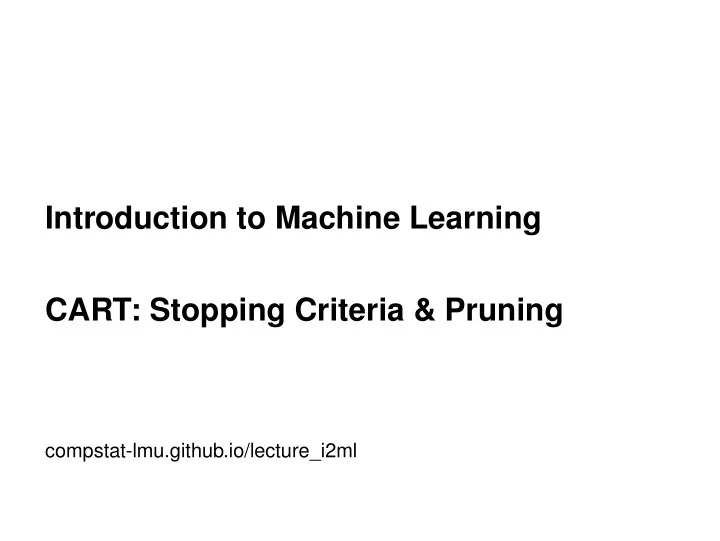

Introduction to Machine Learning CART: Stopping Criteria & Pruning compstat-lmu.github.io/lecture_i2ml
OVERFITTING TREES The recursive partitioning procedure used to grow a CART would run until every leaf only contains a single observation. Problem 1: This would take a very long time, as the amount of splits we have to try grows exponentially with the number of leaves in the trees. Problem 2: At some point before that we should stop splitting nodes into ever smaller child nodes: very complex trees with lots of branches and leaves will overfit the training data. Problem 3: However, it is very hard to tell where we should stop while we’re growing the tree: Before we actually try all possible additional splits further down a branch, we can’t know whether any one of them will be able to reduce the risk by a lot ( horizon effect ). � c Introduction to Machine Learning – 1 / 7
STOPPING CRITERIA Problems 1 and 2 can be “solved” by defining different stopping criteria : Stop once the tree has reached a certain number of leaves. Don’t try to split a node further if it contains too few observations. Don’t perform a split that results in child nodes with too few observations. Don’t perform a split unless it achieves a certain minimal improvement of the empirical risk in the child nodes compared to the empirical risk in the parent node. Obviously: Stop once all observations in a node have the same target value ( pure node ) or identical values for all features. � c Introduction to Machine Learning – 2 / 7
PRUNING We try to solve problem 3 by pruning : a method to select the optimal size of a tree Finding a combination of suitable strict stopping criteria (“pre-pruning”) is a hard problem: there are many different stopping criteria and it’s hard to find the best combination (see chapter on tuning ) Better: Grow a large tree, then remove branches so that the resulting smaller tree has optimal cross-validation risk Feasible without cross-validation: Grow a large tree, then remove branches so that the resulting smaller tree has a good balance between training set performance (risk) and complexity (i.e., number of terminal nodes). The trade-off between complexity and accuracy is governed by a complexity parameter . � c Introduction to Machine Learning – 3 / 7
PRUNING 1 1 23 n=506 100% yes yes rm < 6.9 rm < 6.9 no no 2 2 3 3 20 37 n=430 85% n=76 15% lstat >= 14 lstat >= 14 rm < 7.4 rm < 7.4 5 5 4 4 6 6 7 7 15 23 32 45 n=175 35% n=255 50% n=46 9% n=30 6% Full tree � c Introduction to Machine Learning – 4 / 7
PRUNING 1 1 23 n=506 100% yes yes rm < 6.9 rm < 6.9 no no 2 2 20 n=430 85% lstat >= 14 lstat >= 14 5 5 4 4 3 3 15 23 37 n=175 35% n=255 50% n=76 15% Pruning with complexity parameter = 0.072. � c Introduction to Machine Learning – 5 / 7
PRUNING 1 1 23 n=506 100% yes yes rm < 6.9 rm < 6.9 no no 2 2 3 3 20 37 n=430 85% n=76 15% Pruning with complexity parameter = 0.171. � c Introduction to Machine Learning – 6 / 7
PRUNING 1 1 23 n=506 100% Pruning with complexity parameter = 0.453. � c Introduction to Machine Learning – 7 / 7
Recommend
More recommend